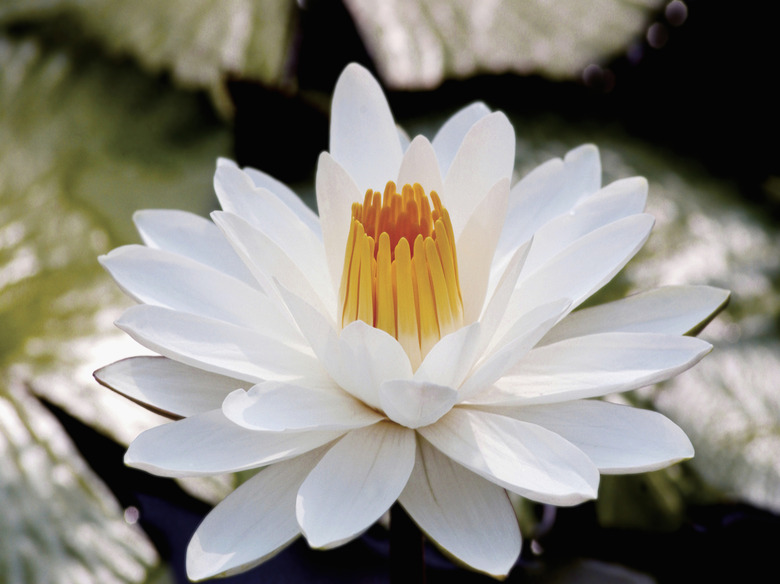Life Cycle Of A Lily Plant
A lily (Lilium sp.) is a flowering plant classified as an angiosperm, a plant that forms seeds in a protective, fleshy carpal. The life cycle of the lily is straightforward, beginning with germination of the seed and growth into a plant with leaves, stem and roots. At maturity, the lily will form a flower, complete with male and female floral parts that will join during fertilization, often assisted by the transfer of pollen to the ovary via an insect. Once fertilized, the ovary develops into a fertile seed.
A lily (Lilium sp.) is a flowering plant classified as an angiosperm, a plant that forms seeds in a protective, fleshy carpal. The life cycle of the lily is straightforward, beginning with germination of the seed and growth into a plant with leaves, stem and roots. At maturity, the lily will form a flower, complete with male and female floral parts that will join during fertilization, often assisted by the transfer of pollen to the ovary via an insect. Once fertilized, the ovary develops into a fertile seed.
Germination
Once the seed of the lily is exposed to appropriate amounts of light, warmth and moisture in the topsoil, the plant embryo will swell and break through the seedcoat. A taproot and shoot will emerge. The cotyledons, or initial leaves ,will poke up from the soil and become green as the initial chlorophyll pigments are formed and photosynthesis begins.
- is a flowering plant classified as an angiosperm, a plant that forms seeds in a protective, fleshy carpal.
- At maturity, the lily will form a flower, complete with male and female floral parts that will join during fertilization, often assisted by the transfer of pollen to the ovary via an insect.
Plant Growth
The juvenile plant will continue to grow, forming more leaves and roots as more food is produced during photosynthesis and the roots continue to absorb water and nutrients. With time, excess food will permit the formation of a bulb in the ground–a collection of scale-like tissues in a rounded mass.
Perennialization
As the first growth year wanes and autumnal cold and frosts kill back the above-ground foliage, nutrients and food will be located in the underground bulb to overwinter.
This perennial plant re-emerges in the warmth of spring, utilizing the stored energy from the bulb for the initial growth spurt of stems and leaves. Throughout the summer, the plant gains strength and vigor as it makes more food during photosynthesis, enough energy in that flowering can be undertaken.
Flowering
The mature plant will manufacture appropriate hormones to initiate flowering according to its genetic code, unique for each species. Stem tips will differentiate into flower buds, eventually swelling to reveal a perfect flower, one with both male and female structures.
- The juvenile plant will continue to grow, forming more leaves and roots as more food is produced during photosynthesis and the roots continue to absorb water and nutrients.
In the center of the flower is the female pistil with its lower ovary, neck-like style and topped by the stigma, the point where the male pollen is received. Surrounding the pistil is a ring of six male-gendered stamens, each with a thread-like stem called a filament and topped by the pollen-shedding sacs in the anther.
Pollination and Fertilization
The six petals attract visual attention to pollinating insects who frequent the stamens for pollen and the sweet nectar of the style. As the insect maneuvers around the flower, pollen grains are deposited onto the style, initiating pollination.
Enzymes are released by the pollen grains and the pollen penetrates the long style tube, eventually finding its way to the ovary. Fertilization takes place. The fusion of the pollen's male DNA with the ovary's female DNA results in the formation of seeds.
- In the center of the flower is the female pistil with its lower ovary, neck-like style and topped by the stigma, the point where the male pollen is received.
- Enzymes are released by the pollen grains and the pollen penetrates the long style tube, eventually finding its way to the ovary.
Maturation of the Seed
Weeks after fertilization, the plant has expended energy into the maturation of the seeds. The swollen ovary, looking like a plump pod, finally dries and browns when the seeds are ripe. The pod cracks and split open, releasing the seeds to drop to the fertile soil below. The seed rests in dormancy in the autumn and winter, awaiting the ideal conditions for germination the following spring.
